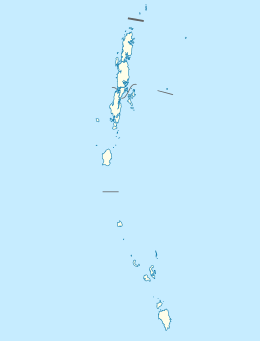Ross Island (Andaman)
|
Location of Ross Island
|
|
| Geography | |
|---|---|
| Location | Bay of Bengal |
| Coordinates | 11°40′30″N 92°45′43″E / 11.675°N 92.762°ECoordinates: 11°40′30″N 92°45′43″E / 11.675°N 92.762°E |
| Archipelago | Andaman Islands |
| Adjacent bodies of water | Indian Ocean |
| Total islands | 1 |
| Major islands |
|
| Area | 0.312 km2 (0.120 sq mi) |
| Length | 1.25 km (0.777 mi) |
| Width | 0.52 km (0.323 mi) |
| Coastline | 3.20 km (1.988 mi) |
| Highest elevation | 45 m (148 ft) |
| Administration | |
| District | South Andaman |
| Island group | Andaman Islands |
| Island sub-group | Port Blair Islands |
| Tehsil | Port Blair |
|
Largest settlement
|
INS Jarawa quarters
|
| Demographics | |
| Demonym | Hindi |
| Population | 10 (2011) |
| Pop. density | 32 /km2 (83 /sq mi) |
| Ethnic groups | Hindu, Andamanese |
| Additional information | |
| Time zone | |
| PIN | 744101 |
| Telephone code | 031927 |
| Official website | www |
| ISO Code | IN-AN-00 |
| Literacy | 84.4% |
| Avg. summer temperature | 30.2 °C (86.4 °F) |
| Avg. winter temperature | 23.0 °C (73.4 °F) |
| Sex ratio | 1.2♂/♀ |
| unit_pref | Metric |
| Census Code | 35.639.0004 |
| Official Languages | Hindi, English |
Ross Island is an island of the Andaman Islands. It belongs to the South Andaman administrative district, Andaman and Nicobar Islands. the island is situated 3 km (2 mi) east from downtown Port Blair.
After Archibald Blair's survey of the Andaman and Nicobar Islands in 1788, a settlement was established at present day Port Blair (then called Port Cornwallis). In 1792 it was shifted to the Northern harbour (present day Diglipur) which was also christened Port Cornwallis (the former became Old Harbour). But, that settlement was abandoned in 1796 because of the high mortality rate. Between 1789-92, Blair established a hospital and a sanatorium at Ross Island.
Six decades later, the 1857 Revolt forced the British to turn to Andaman again. Ever since Dr. James Pattison Walker arrived in Port Blair aboard the East India Company’s steam frigate ‘Semiramis’ on 10 March 1858, this island remained under British occupation. Ross Island remained the Administrative Headquarters for the islands for 85 years before an earthquake rocked it in 1941. The remnants of an opulent past can be seen in the ruins of the bazaar, bakery, stores, water treatment plant, church, tennis court, printing press, secretariat, hospital, cemetery, swimming pool, the Chief Commissioner’s residence with its huge gardens and state grand ballrooms, the Government House, the old Andamanese Home',Troop Barracks, all in dilapidated condition, reminiscent of the old British regime. In November 1857, the Government decided to establish a penal settlement in Andaman and send "hard-core elements" among those who took on the British. There were two reasons: One, to keep them away from other prisoners and the other, to send out a message that a similar treatment would be meted out to anyone who challenged the British authority. In January 1858, the British took possession of three islands in and around Port Blair and Captain H. Man, Executive Engineer, hoisted the Union Jack. In March, J.P. Walker, an experienced jail superintendent, arrived in Port Blair with four European officials, an Indian overseer, two doctors, 50 naval guards and 773 freedom fighters. Gauri Shankar Pandey, who belonged to a family that had suffered atrocities during the Japanese occupation of the Andaman and Nicobar Islands, has documented that it was water scarcity that drove Walker out of Port Blair to Ross Island.
...
Wikipedia

